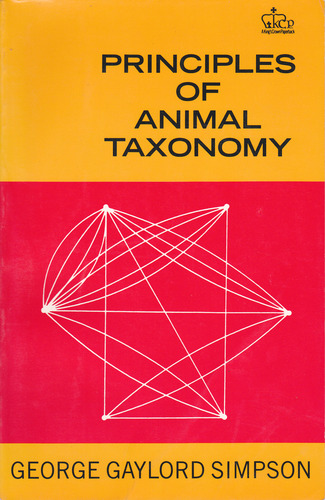Principles of animal taxonomy epub
Par cluck laura le mardi, février 16 2016, 22:32 - Lien permanent
Principles of animal taxonomy by George Gaylord Simpson


Principles of animal taxonomy George Gaylord Simpson ebook
Format: djvu
ISBN: 023109650X, 9780231096508
Page: 131
Publisher: Columbia University Press
Arthropods are the most diversified animal group [1, 2]. While he continued throughout his lifetime to revise and expand this great work, so his successors have continued to revise the principles of taxonomy, now according to genetic principles, informed by the analysis of DNA. From microscopic investigation to the basics of veterinary medicine, Zoology covers principles of comparative animal anatomy, physiology, and genetics. Nomenclature and Classification, Principles of (Insects). The classic example is Linnaeus' animal kingdom taxonomy. Scientifically, it is called taxonomy and rooted in ancient Greek. The system that we still use today for giving scientific names to plants and animals has many founders, from the Greek philosopher Aristotle to the Swedish physician and botanist Carolus Linnaeus. With Darwin's theory, a general acceptance that classification should reflect the Darwinian principle of common descent quickly appeared. We evaluated completeness, accuracy, and historical trend of the taxonomic knowledge on the myrmecophilous ground beetle tribe Paussini (Coleoptera, Carabidae, Paussinae). The first significant definitions were developed by Aristotle. This course begins with an overview of key concepts in zoology as students examine the characteristics of the animal cell and discuss heredity and issues of evolution, including natural selection. Cuvier's The Animal Kingdom, Arranged According to its Organization, Serving as a Foundation for the Natural History of Animals, was an attempt to classify the animal kingdom on the basis of comparative anatomy, of which Cuvier's entire classification schema was Using these principles, Cuvier established a taxonomic approach based on comparative anatomy that established correlations between the inner systems that maintained life within an organism. Comparison of exotic horn types The heroic age of biological taxonomy is long over, but anatomy as an explanatory principle is still able to take over with a special convincing force any wonderful being from the world of legends to our one. Tree of Life representations became popular in scientific works, with known fossil groups incorporated. Classification has two meanings in English: the process by which things are grouped into classes by shared characters and the arrangement of those classes. They then turn to taxonomy, as they study increasingly complex types of animals. While doing a presentation on the Principles of Taxonomy, I was asked the question of “How do you know when to choose a hierarchical taxonomy or a faceted taxonomy? Each recently discovered new animal or prodigious being became understandable and inserted in the common system for once as soon as its anatomy was described and, first of all, depicted.
Uranometria 2000.0 Volume 1 & 2 pdf
Unit roots, cointegration, and structural change ebook